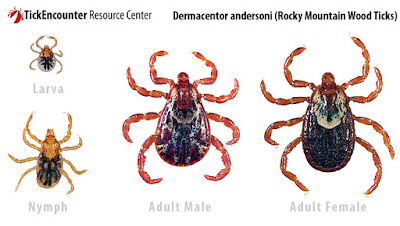I’ve been hearing about ticks recently so let’s do another session of tick talk this year. The following information comes from a recent Montana Urban IPM alert.
The common ticks in Montana this time of the year are the Rocky Mountain wood tick and the American dog tick. The two species look very similar.
The Rocky Mountain wood tick is very common in the
Rocky Mountain region and is found on livestock, companion animals, and humans
in the spring/summer in Montana. It
likes stream corridors, grassy meadows, and south-facing sagebrush slopes. The American dog tick is found in eastern
Montana so we won’t spend any more time on that today. Neither of these species vector Lyme disease. We don’t have either of the two species of
black-legged ticks otherwise known as deer ticks in Montana that vector Lyme
disease.
The Rocky Mountain wood tick transmits Rocky Mountain
spotted fever and Colorado tick fever. Rocky
Mountain spotted fever transmission is rare in our state, with most cases occurring
in the south Atlantic Region. Colorado
tick fever occurs only in western states. In Montana cases have been diagnosed west of
the Continental Divide, and in the southwest and southcentral parts of Montana.
Symptoms of Colorado tick fever occur
within four days and include chills, headache, fever, muscular ache, and
general malaise. |
| Illustration courtesy of TickEncounter Resource Center |
To try and prevent ticks from finding a ride home on
you use a repellent like DEET or picaridin. Use these especially on pants and
check for ticks after being outdoors. If
you’re in a brush-type area or an area with tall grasses, always do your tick
checks right afterwards.
You want to find and remove ticks as soon as possible.
There are some common folklore tick
removal methods such as “backing out of the tick with a burning match” that
should not be attempted. This method is
not safe and doesn’t work. It is
important to try to thoroughly remove the tick and the mouthparts. The tick has mouthparts which are barbed and
used for insertion into the skin. If
these break off, it can be a further source of irritation and possibly
infection. Also, the crushing of the
mouthparts can allow for disease transmission to occur through the skin if not
removed properly. Place your forceps such
as blunt curved forceps or tweezers around the tick mouthparts as close to the
skin as possible. Remove the tick with a
slow, steady pull away from the skin. Don’t
jerk or twist the tick. Avoid getting or
crushing any tick parts on you. Disinfect your skin with alcohol and wash your
hands with soap and water.In Montana, we cannot test the tick itself for diseases. The website www.tickencounter.org has further information on testing ticks for diseases and where you can send them. You must keep the tick alive to test for diseases.
No comments:
Post a Comment